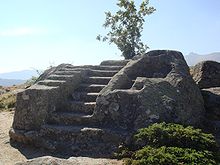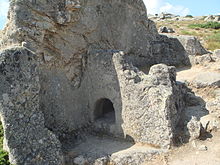Castro de Ulaca
The Castro de Ulaca is a former, partially preserved or reconstructed Celtic fortress from pre-Christian times in the province of Ávila in the autonomous region of Castile-León in central Spain . She is on a about 1100 to 1150 m high mountain near the village Villaviciosa on the territory of the municipality Solosancho , about 30 km route southwest of the city of Ávila . This archaeological site has been systematically explored several times since the middle of the 20th century.
history
The mountain fortress belonged to the tribal area of the Vettonen and was probably from the 7th to the 1st century BC. Settled. Then it was given up in the course of the Romanization of the Iberian Peninsula . At the beginning of the 20th century, the fortification became known when a catalog of monuments for the region started in 1901 but was not published until 1931. Around 1915, the prehistorians Raymond Lantier and Henri Breuil visited the fortress and published about it in 1930. The first systematic investigations of the complex began in the 1940s and were continued in the 1970s and 1990s. The most recent investigations were carried out in 2003 and 2004.
Excavation site
The Castro de Ulaca covers an area of approx. 60 ha, which was surrounded by an approx. 3 km long double wall filled with stone rubble and earth, at least two meters high. The place was also a center of handicraft activities like blacksmithing and pottery . According to its area, it is estimated that the fortress could accommodate around 1500 people. Some lived here permanently, others only sought refuge in times of need.
Sacrificial altar
The most important individual monument in the complex is the “sacrificial altar” (Altar de los Sacrificios) carved out of a large granite block and accessible via a staircase . However, a real altar does not exist or no longer exists; rather there are two cavities in the stone. While the left side of the staircase is also stepped, caves can be seen on the right side, in which water collected after heavy or prolonged rainfall. This was possibly offered as "holy water" or as a libation sacrifice. But animal and even human sacrifices cannot be ruled out either. At the foot of the stairs there is a platform delimited by several monoliths , the function of which is unclear whether it is a place of worship or a meeting area.
sauna
About 200 m from the altar is a building half sunk into the rock, in which some researchers want to see a kind of sweat bath that could also be used for ceremonial cleaning. The main room hugs the rock on three sides; the fourth side was formerly closed with quarry stone masonry . Noteworthy is the arched access carved out of the rock, which could already point to the knowledge of Roman buildings.
Houses
Several house foundations were uncovered on the site and reconstructed up to a height of around 50 cm. Most houses consisted of only one room, others had two or even three rooms.
Verraco
A bull or boar figure ( verraco ) from the Castro de Ulaca was set up in Solosancho.
See also
literature
- Gonzalo Ruiz Zapatero: Guia Castro de Ulaca. Solosancho Ávila , 2005, ( online , pdf).
- Gonzalo Ruiz Zapatero, Jesús R. Álvarez Sanchís: Ulaca, la gran ciudad fortificada de los vettones. In: La Aventura de la Historia. , 2004.
Web links
- Castro de Ulaca as a detailed description with photos at Castros y Verracos (Spanish)
- Castro de Ulaca as a description in Arqueotur (Spanish)
- Castro de Ulaca photo video on Youtube (06:59 minutes)
Individual evidence
- ↑ See literature: Historia de la investigación in: Guia Castro de Ulaca. Solosancho Ávila , pp. 10-12.
- ↑ See literature: Las defensas in: Guia Castro de Ulaca. Solosancho Ávila , pp. 12-15.
- ↑ See literature: EconomÌa y sociedad in: Guia Castro de Ulaca. Solosancho Ávila , p. 33.
- ↑ See literature: Ulaca in: Guia Castro de Ulaca. Solosancho Ávila , p. 8.
- ↑ See literature: El santuario y el altar in: Guia Castro de Ulaca. Solosancho Ávila , pp. 15-19.
- ↑ See literature: La sauna iniciática in: Guia Castro de Ulaca. Solosancho Ávila , pp. 19-22.
- ↑ See literature: Las viviendas in: Guia Castro de Ulaca. Solosancho Ávila , pp. 22-28.
- ↑ See literature: Ulaca, el oppidum in: Guia Castro de Ulaca. Solosancho Ávila , pp. 8–9.
Coordinates: 40 ° 31 '47 " N , 4 ° 53' 8" W.




